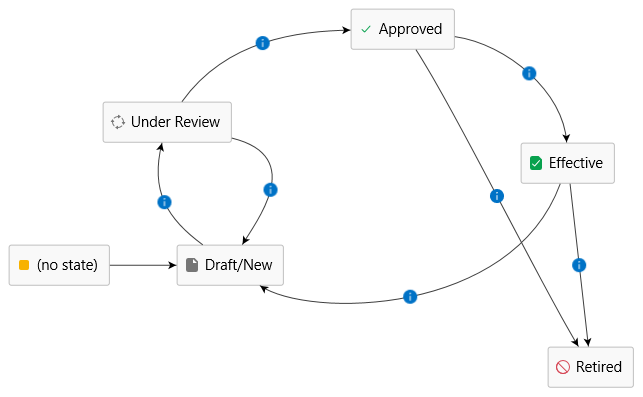Streamlining Controlled Documents with M-Files
Introduction
Maintaining control over critical business documentation is more important than ever. For organisations striving for quality and consistency,
controlled documents are essential. But what exactly are controlled documents, and how can M-Files help streamline their management, especially when aiming for ISO 9001 certification? Let's explore.
What are Controlled Documents?
Simply put, a controlled document is a document that is managed through a formal process of review, approval, distribution, modification, storage and access. These documents aren't static, they evolve with your business and should be kept up-to-date. Typically, these documents include standard operating procedures (SOPs), policies, procedures, work instructions, and records that are crucial for quality assurance, compliance, and operational effectiveness. Controlled documents are critical to ensuring that a company's processes and operations meet required standards and targets.
ISO 9001 Certification and Controlled Documents
Controlled documents are particularly relevant to organisations seeking ISO 9001 certification, the international standard for quality management systems (QMS). ISO 9001 certification demonstrates an organisation's commitment to meeting customer and regulatory requirements. Achieving ISO 9001 certification signifies that an organisation has established a robust framework for consistent quality management. The standard is relevant to businesses across all sectors, from healthcare and manufacturing to engineering and finance. It provides a structured approach to improving processes, enhancing customer satisfaction, and ensuring consistent outputs.
Within the ISO 9001 framework, controlled documents are crucial. They provide a clear, auditable trail of how decisions are made and processes are executed. These documents standardise operations, ensuring consistency in the delivery of products and services. This is key to customer satisfaction and regulatory compliance. Not all documents need to be controlled, but any document critical to the QMS or impacted by changes should be.
M-Files: Your Complete Controlled Document Management Solution
M-Files offers a powerful solution for managing controlled documents, going beyond simple document storage by using metadata to organise and categorise documents. M-Files helps ensure that the correct versions are always accessible to the right people at the right time. Here's how M-Files streamlines controlled document management:
- A Centralised Document Repository: M-Files provides a single platform to store all documentation and manage all processes. This eliminates the chaos of multiple storage locations and ensures that everyone works from a single source of truth. M-Files enables your team members easily access policy documents, work instructions and SOPs from a single location.
- Complete Version Control: M-Files tracks changes and maintains a complete version history, allowing users to revert to previous versions if needed. The system ensures that only the latest approved version of a document is accessible to employees. Importantly, M-Files provides a clear version history and audit trail for ISO 9001 compliance audits.
- Access Control: M-Files allows you to set role-based permissions to ensure that only authorised personnel can access sensitive or confidential information.
- Automated Workflows:
M-Files workflows help automate the process and revisioning of SOP documents. They allow for the automation of tasks, processes and actions that involve documents and information.
Managing Parallel Working and Published Copies in M-Files
M-Files’ Advanced Workflow module provides more granular control over document lifecycles. The module is an extension of standard M-Files workflow, enabling the creation of complex and intricate business processes. One of its key features is the ability to automatically create parallel working copies and published copies of controlled documents.
Here's how it works:
- Working Copy: When a user needs to make changes to a document, they "check out" a working copy. This allows them to edit the document without affecting the "published" version. Importantly, M-Files ensure that only authorised users can edit controlled documents. When an admin sets the working copy to "Effective" in the M-Files workflow, the updated released copy is triggered.
- Published Copy: The official, approved version of the document always remains accessible to all relevant stakeholders. This ensures that only the most current and controlled version is shared and used across the system, preventing the issue of multiple conflicting versions circulating via email or local drives.

This approach ensures that authorised team members can collaborate on document updates while guaranteeing that the official version remains consistent and accessible. It ensures that only valid revisions of documents are available to employees, with older versions hidden to prevent confusion. This feature is critical for managing controlled documents, ensuring that employees are always using the most up-to-date and accurate information.
Importantly, the M-Files Advanced Workflow module enables admins to automatically publish a new released copy of a controlled document after the working copy has been updated and approved. M-Files will automatically supersede the previous published version, name the file with an appropriate versioning label, and publish the new released copy to a location where team members can easily access the new version. All with one mouse click.
Conclusion
M-Files not only helps organisations meet the requirements of ISO 9001 but enhances their overall document management capabilities. By providing a centralised, secure, and efficient way to manage controlled documents, M-Files enables businesses to improve compliance, streamline workflows, and enhance quality management.
If you are looking to optimise document control processes, especially within the ISO 9001 framework, M-Files offers a robust and user-friendly solution. Talk to Innovative Content Management today about how we can help streamline your organisation’s controlled document management.
More Articles




Contact Us
sales@innovativecontent.au
